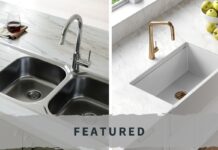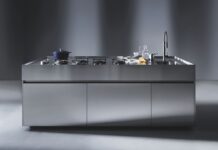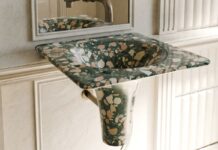 I am constantly drawn to the British online publication “KBB Review”. It is an excellent source of information, advice, commentary and opinion. If you haven’t registered to receive it on a regular basis I would encourage you to do so. And whilst not all the products in this excellent article may relate to your business, much of it will. Written by Hartmut Stein, trainer for the Geberit AquaClean brand, this article advises retailers on how to approach the sales process.
I am constantly drawn to the British online publication “KBB Review”. It is an excellent source of information, advice, commentary and opinion. If you haven’t registered to receive it on a regular basis I would encourage you to do so. And whilst not all the products in this excellent article may relate to your business, much of it will. Written by Hartmut Stein, trainer for the Geberit AquaClean brand, this article advises retailers on how to approach the sales process.
“We humans are a funny lot. We spend ages dreaming of ways we’d make improvements to our home if only we had the resources, but when reality strikes, we’re not that keen on change and more often than not will prefer to stick with what we know.
This is certainly true of how consumers make decisions relating to bathroom design. They tend to dismiss anything that is considered too ‘left field’ or different from what has gone before. Take the shower toilet as a very good example. The majority of consumers visiting their local bathroom showroom for a new WC won’t have considered a shower toilet as an option and so won’t automatically be convinced that it’s the right product for them.
It’s for this reason that as many as 70% of shower toilets are not sold, they are bought. So for the retailer it’s important to consider how your sales technique can be adapted to turn ‘no’ customers into ‘yes please, this is definitely for me’ customers.
The simple answer is, you will only sell such new technologies if you actively sell the products and an important part of this process is understanding the psychology of your customers.
Conforming to type
Essentially, there are four types of customer. Nine per cent of them will be ‘compliant’. These are the ones that are likely to know more about the products you are selling them than you do. You’ll be able to spot them a mile off – look out for the straight back, lack of a smile, long sentences and precise words.
This type of customer is likely to ask questions about security, conforming to standards, time saving and costs. However, with the best will in the world, you’ll be unlikely to convert this customer. They will more than likely pick your brains to affirm their choice and then go and merrily purchase on the internet. That’s not to say you shouldn’t try to sell to them. After all, each time you hone your sales pitch, you’ll get better at it.
The second type of customer is the ‘influence’ customer. These will be communicative, enthusiastic, demonstrative, social and energetic. They’ll be easy to talk to and may have you fooled into thinking they will be an easy sell, only to leave the showroom empty-handed, preferring not to make a decision there and then. Their pleasant character has an ulterior motive – to receive special conditions. It’s important that you recognise the characteristics of ‘influence’ customers, as they make up around 16 per cent of your clientele.

“A similar percentage (15%) are likely to be ‘dominant’ customers and these will be constantly in motion and will use lots of body language. They’ll use their strong voice and self-confidence to put the pressure on you for a discount and might well have done their research on the internet before coming to you to make their purchase. They might seem like a tricky customer, but in fact they want the best of the best. For them, image is everything.
Steady as she goes
The large majority of your customers though, will be in the ‘steadiness’ camp. As many as 60% of them, in fact, will display gentle harmonious gestures and will have a regular and slow kind of way about them. Think of the TV detective Columbo and you’ve summed up this customer in one – albeit probably minus the raincoat and trademark squint. They’ll be walking out of the showroom and then they’ll turn and say ‘just one more thing’. The ‘steadiness’ consumer isn’t interested in all the bells and whistles of a remote control or integrated functions, they favour simplicity over what they perceive to be complicated technology.
These customers are not just your majority, they are also your trickiest customers to win over. But once you have, you’ll never lose them, so it’s well worth the effort. After all, when selling these new bathroom technologies, it’s important to think of the long game. Our findings show that once a customer is sold a shower toilet, they will bring four more customers to you within seven years, so perseverance pays off.
‘No’ is not an option
While each of the four types of customer will require a slightly different sales pitch, there are some tricks to bear in mind that are universal when it comes to selling ‘new’ bathroom technology such as the shower toilet. The most important thing to consider is your own attitude. Don’t, whatever you do, adopt the same ‘no’ attitude as your customers. Justifying the lack of a sale with something along the lines of ‘yes, but they weren’t a Geberit AquaClean-type of customer’ will become a self-fulfilling prophecy. Our brains are conditioned to say no to new things and you’ll simply steer yourself towards a negative result.
Always think positively and remember that the selling starts when the customer says ‘no’. An important rule of thumb is to always talk about the customer and not the product. Show sympathy with your customers and their concerns and this will build their trust. With trust in place, the door is open for you to explain how the product can benefit them and, before you know it, the customer will be willing to pay the price.
Best value
‘Did you know’ questions are a helpful way of engaging with your customers rather than simply bombarding them with facts and figures that they feel they have little use for. Replace an attacking stance with ‘did you know it only costs around £2 a month to run in water and electricity?’ and you’ll really have them thinking. And when it does come down to the nitty-gritty of price, remember to speak in terms of value rather than cost. Trust me, the difference is massive. That’s because – back to the psychology lesson for a moment – all buying decisions are made by the limbic part of the brain, which is the reward centre.
The neocortex part of the brain, on the other hand, is involved in price and cost. So if you say something has a ‘value of…’ it will appeal to the emotional part of the brain. The word ‘cost’ goes straight to the neo-cortex and is received in a similar way to pain. So think ‘value’ not ‘cost’ to save your customers from reaching for the paracetamol. Finally, our experience suggests that for every 11 people that try a shower toilet when making their purchasing decisions, six will go on to buy one, making experiential selling a vital tool in the salesman’s arsenal.
However, even this needs to be handled carefully. Again, watch your language. Rather than saying ‘you can try it out if you like’, instead say ‘I’d like to invite you to take the Geberit AquaClean test’. This switches on the guilty feeling in your customer’s brain – known by the catchy title of the psychological rule of reciprocity.
It is apparent then that there is a science to selling bathroom technology, but it’s one that, once learnt, will turn more of your ‘no’ customers into ‘yes, you’ve sold me’ customers. Because deep down, we all know that change is a good thing.”
Well written Hartmut I say – what do you think?
Register for KBB Review at www.kbbreview.com


































